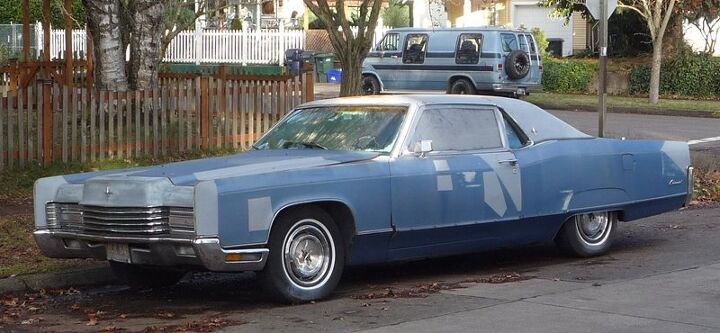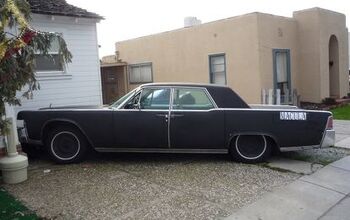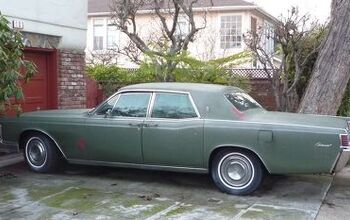Curbside Classic: 1970 Lincoln Continental Coupe

Ever since I found this relatively rare 1970 Continental Coupe, I’ve been trying to find something good to say about it. Don’t get me wrong; I love it, in its intrinsic hugeness and badness. But then I had a crush on Blaze Starr in seventh grade too. And I was just about as thrilled to find it in this neighborhood of old Toyotas and Volvos as if Blaze herself was suddenly sauntering down the sidewalk au naturel. 1970 Lincolns, especially the coupe, are rare these days; that pretty much goes for the whole ’70-74 generation. Devoid of the ’61’s clear angular brilliance, heavily influenced by GM’s big barges, and lacking the in-your-face over-the-top I’m-big-and-I’m-proud excess of their ’75-’79 successors, these are almost forgotten now. Shall we call them the lost Lincolns? Oh wait; I think I just came up with something positive…
We could call them the hot rod Lincolns! I know that’s a bit of a stretch, but seriously, this ’70 Coupe was undoubtedly the fastest Lincoln ever up to that time, and would easily hold that crown until the 1987 Mark VII SLC. The 460 cubic inch (7.4 liter) was still in its high-compression youthful freshness, rated at 365 (gross) hp. And although the 1970 Lincoln was a completely new car, with a bigger wheelbase than its predecessor and now riding on a gen-u-ine frame, it actually weighed less than the heavyweight unibodies it replaced. My Encyclopedia of American cars says this coupe weighed a relatively svelte 4,669 lbs; about the same as today’s Audi S8.
The same was true for the Cadillac of the times; the ’68 Coupe DeVille weighed in at about 4,600 lbs, and had the new 375 hp 472 V8. It would be a blast to see a couple of these big barges drag race each other. I can’t find any old road test numbers for the Lincoln, but ’68-’69 Caddys could do 0-60 in about 9 seconds, and the quarter mile in sixteen. Not so hot from today’s perspective, but considering the technology of the times and the utter effortlessness with which these boats hustled along, those numbers are not too shabby.
Flooring one of these big girls at sixty still gave a noticeable shove in the back. The emasculated de-smogged versions soon to come would get to sixty within a somewhat reasonable time, but from there on up, they were utterly out of wind. Just in time for the double nickel.
See; I managed some positive spin for this bad girl. But that’s about as far as I can take it. So if you’re negativity averse, better stop here. And I’m not even going to use the words “handling”, or “build quality”.
Let’s face it: these Lincolns are just Ford LTDs with a bit of collagen and silicone. The big and wide new ’69 Ford was designed with a one-frame-fits-all strategy. Ok, the Lincoln’s side rails are a couple of inches longer, but when it comes down to it, they’re all of a family; cut from the same cloth. Ford’s experiment with its a-cut-above unibody Continentals was over; pragmatism was the new order of the day. Lincolns from here on out would be a trim level above the LTD, with the Marquis precariously squeezed between.
Ford’s pricing strategy certainly made that inevitable. This 1970 Continental was 20% cheaper than the 1961, adjusted for inflation. Ford was going for the volume, as Caddy had for some time. Anyway, the doctors and lawyers were all driving Mercedes by now, so why bother with genuine exclusivity? The seventies were the democratization of many things, but nothing more so than “luxury” items. Shag carpeting was laid over the linoleum floor (which is in again), and soft-padded opera-windowed padded tops sprouted on suburban driveways like the crab grass in the lawns.
This ’70 is the transition to that era; the opera windows are still a couple of years away. In a way, the understated dull boringness of this car is also its redeeming feature, along with its healthy motor. Might explain why this owner is going to some lengths to keep it running on the street, despite the broken-out side window and the largely disassembled instrument panel. It’s someone’s beloved hot rod Lincoln, so watch what you say. I did.

More by Paul Niedermeyer
Latest Car Reviews
Read moreLatest Product Reviews
Read moreRecent Comments
- Honda1 Unions were needed back in the early days, not needed know. There are plenty of rules and regulations and government agencies that keep companies in line. It's just a money grad and nothing more. Fain is a punk!
- 1995 SC If the necessary number of employees vote to unionize then yes, they should be unionized. That's how it works.
- Sobhuza Trooper That Dave Thomas fella sounds like the kind of twit who is oh-so-quick to tell us how easy and fun the bus is for any and all of your personal transportation needs. The time to get to and from the bus stop is never a concern. The time waiting for the bus is never a concern. The time waiting for a connection (if there is one) is never a concern. The weather is never a concern. Whatever you might be carrying or intend to purchase is never a concern. Nope, Boo Cars! Yeah Buses! Buses rule!Needless to say, these twits don't actual take the damn bus.
- MaintenanceCosts Nobody here seems to acknowledge that there are multiple use cases for cars.Some people spend all their time driving all over the country and need every mile and minute of time savings. ICE cars are better for them right now.Some people only drive locally and fly when they travel. For them, there's probably a range number that works, and they don't really need more. For the uses for which we use our EV, that would be around 150 miles. The other thing about a low range requirement is it can make 120V charging viable. If you don't drive more than an average of about 40 miles/day, you can probably get enough electrons through a wall outlet. We spent over two years charging our Bolt only through 120V, while our house was getting rebuilt, and never had an issue.Those are extremes. There are all sorts of use cases in between, which probably represent the majority of drivers. For some users, what's needed is more range. But I think for most users, what's needed is better charging. Retrofit apartment garages like Tim's with 240V outlets at every spot. Install more L3 chargers in supermarket parking lots and alongside gas stations. Make chargers that work like Tesla Superchargers as ubiquitous as gas stations, and EV charging will not be an issue for most users.
- MaintenanceCosts I don't have an opinion on whether any one plant unionizing is the right answer, but the employees sure need to have the right to organize. Unions or the credible threat of unionization are the only thing, history has proven, that can keep employers honest. Without it, we've seen over and over, the employers have complete power over the workers and feel free to exploit the workers however they see fit. (And don't tell me "oh, the workers can just leave" - in an oligopolistic industry, working conditions quickly converge, and there's not another employer right around the corner.)





































Comments
Join the conversation
Regarding the comment from johnster.....the chrysler RB and ford 385 series were very well designed engines, perfectly suited to Imps and lincolns. The big block chevy was junk, from a reliability standpoint. Very notorious for broken valve springs and rocker arms. And they had excessive cam wear problems, even worse than the chevy small block. Many big block chevies had flat cams before even hitting 50k. And chevy blocks had the lowest amount of nickel of just about any V8 block made in those days, not good as far as bore wear goes. So it's good that cadillac never used the big chevy. it would have been a disaster, pretty much like some of cadillac's later engines to come.
When I was 17, I bought a 1970 Lincoln Continental in 1977 from an uncle (used car dealer) for $1K. It had nearly 90K miles on the odometer when I bought it. It had a tiny little scrape in the paint just above the grill (garage door?) but other than that, perfect bumpers and paintwork. My father had been driving huge Chrysler's and Plymouth's while I was growing up so I thought nothing of the great size of the vehicle; I liked the car because it was a two-door coupe and I liked the fender skirts. I think the car had the highest level of equipment I've ever experienced in a car. Automatic dimming headlights, fully carpeted trunk, leather seats, seek/scan radio--the works. It wasn't exciting to drive, but it was comfortable, predictable and would let me know well in advance if I was pushing it beyond its limits. I drove the car for a couple of years until I was rear-ended by a drunk driver with no insurance (I only carried liability) and the car was damaged beyond my ability to have it repaired. It wasn't until after it was gone, and I went looking for a replacement (I settled on a 1979 Thunderbird) that I realized how special that car really was, in terms of the "long, low & lovely" looks I had admired in cars so much as I was growing up, the ride quality, level of equipment and the all-around "aura" of simply being what it was--a Lincoln. I found a picture of the Lincoln today. I'll never forget that car. I wish cars could look like that again.